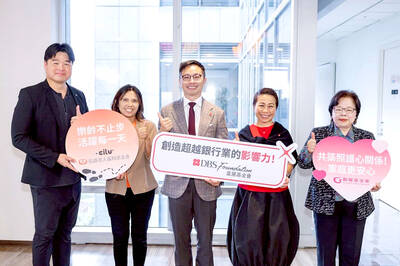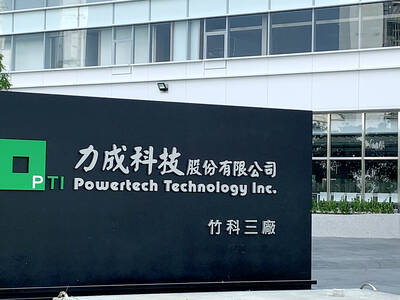Apple Inc plans to start selling Mac computers with its own main processors by next year, relying on designs that helped popularize the iPhone and the iPad, people familiar with the matter said.
The Cupertino, California-based technology giant is working on three of its own Mac processors based on the A14 system-on-a-chip processor in the next-generation iPhone, the people said, adding that the first would be much faster than the processors in the iPhone and iPad.
Apple is preparing to release at least one Mac with its own chip next year, they said.
However, the initiative to develop multiple chips, codenamed Kalamata, suggests that the company will transition more of its Mac lineup away from current supplier Intel Corp.
Taiwan Semiconductor Manufacturing Co (TSMC, 台積電), Apple’s partner for iPhone and iPad processors, is to build the new Mac chips, said the people, who asked not to be identified discussing private product plans.
The components would be based on a 5-nanometer production technique, the process size Apple is to use in the next iPhones and iPad Pros, one of the people said.
An Apple spokesman declined to comment, as did Intel and TSMC.
Apple is designing more of its own chips to gain greater control over the performance of its devices and differentiate them from rivals.
Getting Macs, iPhones and iPads running the same underlying technology should make it easier for Apple to unify its apps ecosystem and update its computers more often.
The move would also reduce reliance on Intel, which has struggled to maintain annual increases in performance it once offered.
Mobile device chips designed by Apple have multiple processing units, or cores, that handle different types of tasks.
The latest iPad Pro has four cores for performance-intensive workloads and another four to handle low-power tasks to preserve battery life.
The first Mac processors would have eight high-performance cores, codenamed Firestorm, and at least four energy-efficient cores, known internally as Icestorm, the people said, adding that Apple is exploring Mac processors with more than 12 cores for further in the future.
In some Macs, Apple’s designs would double or quadruple the number of cores that Intel provides. For example, the current entry-level MacBook Air has two cores.
Like Qualcomm Inc and the rest of the mobile semiconductor industry, Apple designs its smartphone chips with technology from Arm Inc, which is owned by Softbank Group Corp. These components often use less energy than Intel’s offerings.
However, in the past few years Arm customers have tried to make processors that are also more powerful.
The transition to in-house Apple processor designs would likely begin with a new laptop, because the company’s first custom Mac chips would not be able to rival the performance Intel provides for high-end MacBook Pros, iMacs and the Mac Pro desktop.
The switch away from Intel would be complex, requiring close collaboration between Apple’s software, hardware and component-sourcing teams.
Given work-from-home orders and disruptions to the company’s Asia-based supply chain, the shift could be delayed, the people said.
Like with the iPhone, Apple’s Mac processors would include several components, including the main processor, known as a central processing unit, and the graphics processing unit.
Apple’s lower-end computers currently use Intel for graphics, while it has partnered with Advanced Micro Devices Inc for graphics cards in its professional-focused offerings.
The Kalamata project has been under way for several years. In 2018, Apple developed a Mac chip based on the iPad Pro’s A12X processor for internal testing.
That gave the company’s engineers confidence that they could begin replacing Intel in Macs as early as this year, Bloomberg News reported.
Apple has already started designing a second generation of Mac processors that follows the architecture of chips planned for next year’s iPhone. That indicates that Apple wants to put its Macs, iPhones and iPads on the same processor development cycle.

US sports leagues rushed to get in on the multi-billion US dollar bonanza of legalized betting, but the arrest of an National Basketball Association (NBA) coach and player in two sprawling US federal investigations show the potential cost of partnering with the gambling industry. Portland Trail Blazers coach Chauncey Billups, a former Detroit Pistons star and an NBA Hall of Famer, was arrested for his alleged role in rigged illegal poker games that prosecutors say were tied to Mafia crime families. Miami Heat guard Terry Rozier was charged with manipulating his play for the benefit of bettors and former NBA player and

The DBS Foundation yesterday announced the launch of two flagship programs, “Silver Motion” and “Happier Caregiver, Healthier Seniors,” in partnership with CCILU Ltd, Hondao Senior Citizens’ Welfare Foundation and the Garden of Hope Foundation to help Taiwan face the challenges of a rapidly aging population. The foundation said it would invest S$4.91 million (US$3.8 million) over three years to foster inclusion and resilience in an aging society. “Aging may bring challenges, but it also brings opportunities. With many Asian markets rapidly becoming super-aged, the DBS Foundation is working with a regional ecosystem of like-minded partners across the private, public and people sectors

BREAKTHROUGH TECH: Powertech expects its fan-out PLP system to become mainstream, saying it can offer three-times greater production throughput Chip packaging service provider Powertech Technology Inc (力成科技) plans to more than double its capital expenditures next year to more than NT$40 billion (US$1.31 billion) as demand for its new panel-level packaging (PLP) technology, primarily used in chips for artificial intelligence (AI) applications, has greatly exceeded what it can supply. A significant portion of the budget, about US$1 billion, would be earmarked for fan-out PLP technology, Powertech told investors yesterday. Its heavy investment in fan-out PLP technology over the past 10 years is expected to bear fruit in 2027 after the technology enters volume production, it said, adding that the tech would

YEAR-END BOOST: The holiday shopping season in the US and Europe, combined with rising demand for AI applications, is expected to drive exports to a new high, the NDC said Taiwan’s business climate monitor improved last month, transitioning from steady growth for the first time in five months, as robust global demand for artificial intelligence (AI) products and new iPhone shipments boosted exports and corporate sales, the National Development Council (NDC) said yesterday. The council uses a five-color system to measure the nation’s economic state, with “green” indicating steady growth, “red” suggesting a boom and “blue” reflecting a recession. “Yellow-red” and “yellow-blue” suggest a transition to a stronger or weaker condition. The total score of the monitor’s composite index rose to 35 points from a revised 31 in August, ending a four-month